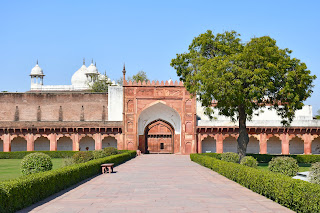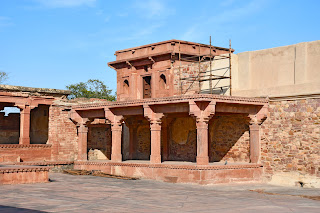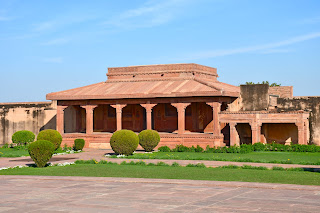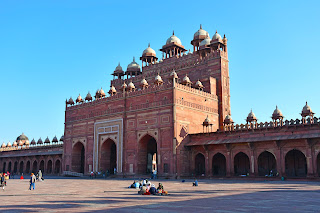Agra and Fatehpur Sikri
On my penultimate day in Northern India, I went on another guided tour. My cab picked me up at six o’clock in the morning, and we met the guide in Agra after nine. Our first stop was Taj Mahal. While it may seem counterintuitive to begin an excursion with the most spectacular sight, it makes sense when one considers the sheer number of tourists who start pouring in throughout the day. Even at this hour, the place was bustling, and my guide hurried forward at breakneck speed in a futile attempt to beat the crowds.
Once again,
I had to acknowledge that having a local guide is very useful. For one, mine
had the good sense to stop a hawker and buy covers to wrap around our shoes:
one must either wear these or take off one’s footwear before ascending to the
upper marble platform of the Taj Mahal. Furthermore, my guide was an
indispensable fount of trivia about the site, though not all of it was factual.
He made multiple references to the debunked story of a black Taj Mahal, so I did
not know how much trust I should put in the other teachings he imparted on me:
that the minarets were built with an outward tilt so as not to damage the
central structure in the case of an earthquake; that the calligraphy at the top
is bigger to compensate for its being farther away; and that the various materials
were imported from as far as Tibet and Afghanistan.
Part of the
reason why so many people were queuing up for the central structure was that
the tomb of Mumtaz Mahal and Shah Jahan had been opened. This special occasion,
my guide told me, only takes place on three days of the year, attracting Muslim
as well as Hindu worshippers. This year is also quite important, marking the
369th anniversary of the Taj Mahal’s completion. Or at least that is
what my guide said; according to my quick research he was off by seven years.
Under the
supervision of guards in military fatigues, the visitors descended a narrow
staircase into a square marble hall. The air was thick, warm, and distinctly
deoxygenated – a fan stood uselessly in the corner, pushing around the same
stale soup. Walking clockwise, we circled Mumtaz Mahal’s tomb, which was draped
in a green cloth and specked with various offerings. Shah Jahan’s larger tomb
stood somewhat off centre, decorated in a similar way except its cloth was a
purplish blue. My guide told me that exactly above these two tombs stand their
marble replicas. This is to prevent people from walking directly over them and
dishonouring the deceased royals.
After
leaving the Taj Mahal, we broke for lunch and continued by car to Agra Fort. Despite
its iconic outer walls built of the local red sandstone, the fort contains a
number of smaller structures both red and white. One of the marble halls, in
fact, is where Shah Jahan lived under house arrest until his death in 1666. Its
walls are inlaid with precious stones, many of which have been pilfered over
the years. Besides that, the fort contains the various living quarters of the
emperor’s family and harem, as well as his multiple audience halls. As I was
told, a large section of the fort is in use by the Indian army and is off
limits to tourists. This custom dates to the times of the British, who
converted much of the fort to barracks for their own troops.
We
completed our itinerary for Agra with a brief visit to a local marble workshop.
I was confident I would not buy anything and by the looks of it, so was the
owner. After going through the motions of a short presentation, he pushed very
little for me to buy anything and took a “thank you for your time” without a
fight.
We
completed our itinerary for Agra with a brief visit to a local marble workshop.
I was confident I would not buy anything and by the looks of it, so was the
owner. After going through the motions of a short presentation, he pushed very
little for me to buy anything and took a “thank you for your time” without a
fight.
My Agra
tour guide did not continue with us to Fatehpur Sikri, for which the agency had
contracted another local guide. Together, we rode a tour bus to the entrance of
the complex, as it is off limits to private vehicles. Our visit began at the
royal palace, which was built by Mughal Emperor Akbar and exhibits many of his
personal idiosyncrasies. Walking past the gate, the guide turned my attention
to a red stone in the garden. It was this stone on which the victim’s head
would rest in Akbar’s infamous executions by elephant trampling.
However, Akbar
also had a more humane, idealistic side. At the centre of the main diwan stands
a pillar whose various etchings (geometric patterns, lotuses, and other floral
designs) symbolise different religions, the message being one of religious
unity and harmony. At least this is what my guide told me, and once again, I took
it with a grain of salt. He further alleged that each of Akbar’s wives belonged
to a different religion: one was a Hindu, one was a Muslim, and one was a
Christian from Goa. Their habitations were all built to reflect their
culturally dictated artistic sensibilities: the Muslim wife’s full of fine
filigrees, the Christian’s plastered with paintings, and the Hindu’s boasting
blossoms of stone. In all likelihood, Akbar’s Christian wife is but a legend,
and even historians who allege her existence acknowledge she is not mentioned
in any contemporary sources.
It was the
Hindu wife who bore Akbar a much-desired son, but only after fervent prayer and
a visit to a Muslim soothsayer. In return for his services, the soothsayer was
entombed within a beautiful marble structure in the nearby Jama Masjid – our
second destination. The mosque has a massive courtyard, which even houses an
outdoor cemetery for men and an indoor cemetery for women. Opposite the mosque
stands the eastern gate, and left of it the monumental Buland Darwaza, one of
the biggest gates in the world. The gate commemorates Akbar’s subjugation of
the Deccan Plateau, which it overlooks from atop a hill as it gazes beyond the
boundaries of the city.
A visit to
Jama Masjid also involves a bit of interesting superstition. The pilgrim
purchases a cloth, some flowers, and a string, bringing these to the tomb of
the soothsayer. After laying the cloth on top of the tomb, they sprinkle the
cloth with flowers and tie the string on a nearby carved window. With each
knot, the visitor makes a wish, the maximum being three. One then receives a
blessing from a brush of some sort and sets off on their merry way. Of course,
the prices for this exercise are highly exaggerated for tourists, but these are
won over by the promise that the cloths will be given to the poor. Reportedly,
these people pray for their benefactors upon receiving their cloths, which is probably
the mechanism by which the wishes are supposed to come true.
My visit to Fatehpur Sikri would not be complete without another stop at a local craftsman, this time a stonemason. The man was very insistent but every time I felt tempted by his persuasions I remembered the maddening number of dust-collectors we have at home – a sentiment even more powerful than the awkwardness of rejection. The subsequent drive back to Delhi took around four hours. We gathered a significant delay at Mathura, the legendary birthplace of Krishna, and from the explanations of my driver I gathered some kind of festivity was underway. We also lost much time at a toll booth an hour away from Delhi, but I have no idea what the problem was. All I saw was the driver switching from lane to lane after being rejected at the booths in a Kafkaesque fashion.



























































Comments
Post a Comment